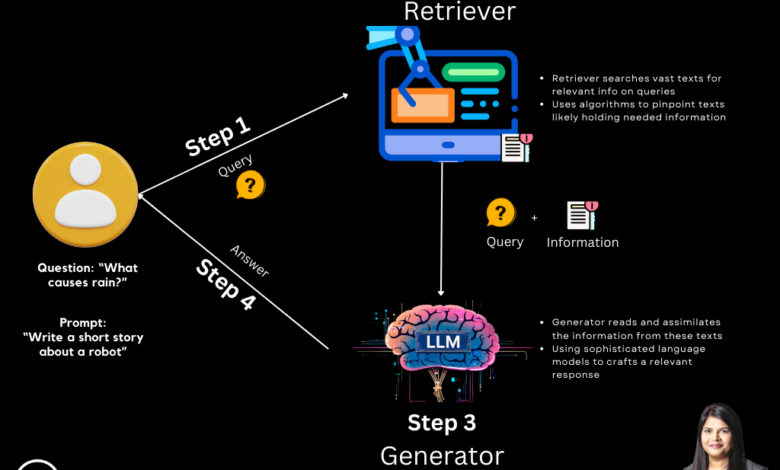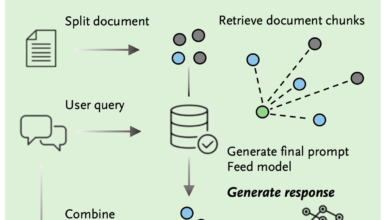Understanding RAG. Generative AI is changing the way we… | by Aruna Pattam | Apr, 2024

Generative AI is changing the way we use technology by making devices smarter and more helpful. One exciting development is called Retriever-Augmented Generation (RAG). It’s like combining Google’s quick search feature with a storyteller’s creativity. RAG helps computers find information quickly and use it to write stories or answer questions in a clear and useful way.
This article will explore how RAG works and why it’s a big deal for our everyday tech use.
Artificial Intelligence (AI) acts like a smart robot that learns human tasks, such as recognizing faces, suggesting movies, or driving cars. It’s like a quick-learning student that improves with practice.
Generative AI, a branch of AI, focuses on creating content, whether it’s writing stories or composing music, mimicking human creativity.
Natural Language Processing (NLP) is another AI field dedicated to understanding and using human language. It teaches computers to communicate in human languages, enabling them to chat, answer queries, or translate between languages.
Together, these technologies are enhancing how computers understand and interact with the world around them.
Retriever-Augmented Generation (RAG) is a novel approach in the field of Generative AI that significantly enhances the capabilities of foundation models, especially in the realm of natural language processing (NLP).
Foundation models, such as GPT (Generative Pre-trained Transformer) and BERT (Bidirectional Encoder Representations from Transformers), are pre-trained on vast amounts of data to understand and generate human-like text. RAG builds on this foundation by integrating a powerful retrieval function that dramatically improves the specificity and relevance of the text generated by these models.
To understand RAG better, imagine you are using a sophisticated Generative AI to write an essay or a report. Traditional foundation models generate content based on patterns and information they learned during training. However, they might lack the latest information or specific details about niche topics. Here’s where RAG comes into play: it combines the generative power of these models with the ability to search and retrieve the most relevant and up-to-date information for any given topic.
Let’s now look at how Retriever-Augmented Generation (RAG) works:
Step 1: The Question or Prompt
Everything begins with a user input, which could be a question (“What causes rain?”) or a prompt for content generation (“Write a short story about a robot”).
This is the starting point for RAG’s operations.
Step 2: Retrieving Relevant Information
The first major component of RAG is the “Retriever.”
When RAG receives a query, the Retriever’s job is to quickly sift through a vast database of texts — which could include books, websites, scientific articles, and more — to find relevant information. This is similar to someone using a search engine to gather material before writing a paper. The Retriever uses algorithms to evaluate which pieces of text are most likely to contain the information needed to answer the question or develop the story.
Step 3: Generating the Text
Once the Retriever has selected the relevant documents, the second component of RAG, known as the “Generator,” comes into play.
The Generator reads and assimilates the information from these texts. Using sophisticated language models, it then crafts a coherent and contextually relevant response.
If the query was about rain, the Generator would use the retrieved data to explain meteorological concepts in simple terms.
For a story, it would weave the data into a narrative featuring a robot.
Step 4: Delivering the Response
The final text generated by RAG is then delivered as the answer to the user’s question or as the completed content for the given prompt. This text is not only informed by the most relevant and recent information but is also structured in a way that is natural and easy to understand.
By seamlessly integrating these steps, RAG provides a powerful tool for both information retrieval and content creation. It ensures that the responses are not only based on educated guesses or predefined answers but are informed by the latest and most relevant data available, thereby enhancing the reliability and accuracy of automated text generation. This streamlined process makes RAG an invaluable asset in fields ranging from customer support and education to creative writing and journalism.
Retriever-Augmented Generation (RAG) is a versatile Generative AI technology that can be adapted across various sectors to enhance information retrieval and content generation.
Here are some examples of how RAG can be utilized in different sectors:
Banking
In the banking sector, RAG can revolutionize customer service by providing real-time, accurate answers to customer inquiries about products such as loans, mortgages, and savings accounts.
For instance, when a customer asks about the best mortgage rates available, the RAG system can instantly retrieve the most current information and generate a personalized explanation of the mortgage terms, conditions, and rates based on the customer’s profile.
Insurance
Insurance companies can use RAG to streamline claim processing and customer service. By accessing a comprehensive database of policy details and historical claims information, RAG can instantly provide policyholders with information on coverage limits, process claims statuses, and even suggest steps to resolve issues or complete claims forms accurately.
Telecommunications
For telecom companies, RAG can improve customer support by generating troubleshooting guides and quick answers to common issues such as service disruptions, billing inquiries, and account updates. By quickly retrieving information from the vast database of FAQs and support documentation, RAG can provide step-by-step solutions that are tailored to the user’s specific problems and queries.
Public Sector
In the public sector, RAG can be employed to enhance accessibility to governmental information, helping citizens understand complex regulations, application processes for permits, or public health guidelines.
For example, RAG could automatically generate simplified summaries of tax compliance procedures or eligibility criteria for welfare programs based on the specific inputs from the user.
Healthcare
In healthcare, RAG can support medical professionals by quickly pulling up medical records, research articles, and treatment guidelines to assist in diagnosing or creating personalized treatment plans. For patients, it can provide understandable explanations of medical conditions, potential treatments, and procedural steps, thereby improving patient education and engagement.
By implementing RAG, organizations across various sectors can not only enhance operational efficiency but also significantly improve customer experience, compliance with regulations, and decision-making processes.
This technology ensures that both staff and customers have access to the most relevant and current information, tailored specifically to their needs.
Some of the key benefits of using RAG includes:
Enhanced Efficiency and Accuracy:
RAG automates complex tasks like data retrieval and document synthesis, greatly reducing time spent and increasing accuracy in critical fields such as law and medicine.
Boosted Productivity:
By automating routine tasks, RAG helps organizations respond faster to inquiries and maintain communication consistency, enhancing overall workflow efficiency.
Fostering Creativity:
RAG generates unique content from diverse sources, boosting creativity in fields like marketing and content creation, and stimulating innovative thinking among team members.
Accessibility to Information:
RAG simplifies complex data, making sophisticated insights accessible to a wider audience, especially valuable in educational settings.
RAG combines data retrieval and text generation to improve workflows and expand knowledge bases effectively.
Retriever-Augmented Generation (RAG) acts as an indispensable assistant that revolutionizes our engagement with information. By adeptly fetching relevant data and seamlessly transforming it into clear, usable text, RAG not only enhances accuracy and efficiency but also fuels creativity and broadens access to complex data.
As we look to the future, consider the potential of integrating RAG into your daily workflow. Whether you’re refining business strategies, streamlining academic research, or simply enhancing your creative endeavors, RAG offers a myriad of applications that can significantly improve how you process and utilize information. Embrace this technology to make your tasks more manageable and your decisions more informed.



